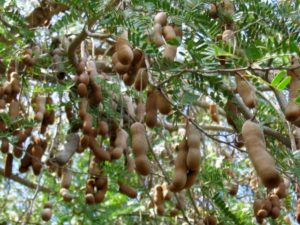 Introduction of Tamarind: – Tamarind is one of the ingredients that are being used in Indian curries, Chuthneys, Sauces and soups for sweet and sour taste. Tamarind is sweetish and its pulp has laxative properties. Tender leaves, flowers and seeds are used as vegetables in India; tamarind kernel powder is also used in sizing material in leather and textile industry. Tamarind seeds yield fatty oil which is being used in paints and varnishes. Tamarind wood also used for multi-purpose like in tool handles, agricultural tools. In India, Tamarind is grown is most of the states, but highly producing states are Bihar, Odhisa, Maharashtra, Tamil Nadu and Andhra Pradesh.
Introduction of Tamarind: – Tamarind is one of the ingredients that are being used in Indian curries, Chuthneys, Sauces and soups for sweet and sour taste. Tamarind is sweetish and its pulp has laxative properties. Tender leaves, flowers and seeds are used as vegetables in India; tamarind kernel powder is also used in sizing material in leather and textile industry. Tamarind seeds yield fatty oil which is being used in paints and varnishes. Tamarind wood also used for multi-purpose like in tool handles, agricultural tools. In India, Tamarind is grown is most of the states, but highly producing states are Bihar, Odhisa, Maharashtra, Tamil Nadu and Andhra Pradesh.
Health Benefits of Tamarind: – Following are some of the health benefits of Tamarind.
• Tamarind supports digestive health.
• Tamarind is good for heart health.
• Tamarind is a good source of iron, hence good blood circulation.
• Tamarind may aid in nerve function.
• Tamarind aids in weight loss.
• Tamarind also helps in managing diabetes.
Local names for Tamarind in India: – Imli (Hindi, Punjabi), Tetul (Bengali), Amli (Gujarati), Hunise hannu (Kannada), Tamber (Kashmiri), Puli (Malayalam, Tamil), Chintha pandu (Telugu), Chinch (Marathi), Tentuli (Oriya).
Main Tamarind production states of India: – Odhisa, Bihar, Maharashtra, Tamil Nadu, Andhra Pradesh and Himalayan tract.
Varieties of Tamarind in India: – There only few varieties available in India.
• PKM1: – This is an early variety which yields about 270 to 300 kg pods/tree with a pulp content of 40%. If the plants are spaced at 10 meter by 10 meter, they  produce yield of 25 tones of pods/hectare.
produce yield of 25 tones of pods/hectare.
• Urigam: – This is a local variety having sweet taste and long pods.
Climate Required for Tamarind farming: – This can survive in any kind of climatic conditions from 0ᵒ C to 46ᵒ C. It grows well in semi arid tropical regions with an average annual rain fall of 5 centimeter to 15 centimeter. This tree also can be grown in heavy rainfall areas provided with good internal soil drainage. Generally the optimum elevation of tamarind is 1000 meter above the mean sea level.
Harvesting in Tamarind farming: – The plants grown from seedlings can start yielding from 8th year where as the plants from grafts and budding can start yielding from 4th year. Hand picking or beating with a stick can be practiced as part of harvesting tamarind fruit.
Yield in Tamarind farming: – As average yield of 30 tones of pods/hectare can be obtained with good farm management practices.
Tamarind
Copyright © 2025
